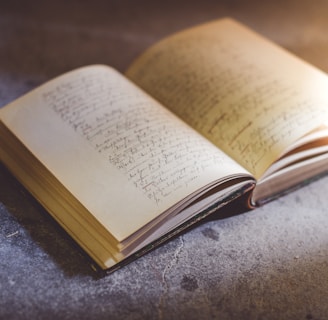Harnessing the Power of Subtext in Writing
Bibliotheca Exotica
4 min read


As writers, we are constantly seeking ways to engage and captivate our readers. We want our words to resonate, to evoke emotions, and to leave a lasting impact. One powerful tool that often goes unnoticed is subtext - the art of conveying deeper meanings without explicitly stating them. In this blog post, we will explore the art of using subtext in writing and offer techniques for writers to subtly embed themes, emotions, and character motives, enhancing the depth and complexity of their work.
Understanding Subtext
Subtext is the underlying message or meaning that is implied rather than directly stated in a piece of writing. It adds layers of depth and complexity to a story, allowing readers to engage in active interpretation. By leaving certain details unsaid, writers create an air of mystery and intrigue, inviting readers to delve deeper into the narrative.
Subtext can be found in various elements of storytelling, including dialogue, actions, descriptions, and even silences. It allows writers to convey emotions, conflicts, and themes in a more nuanced and subtle manner, making the reading experience more immersive and thought-provoking.
Techniques for Harnessing Subtext
1. Dialogue and Unspoken Words
One of the most effective ways to incorporate subtext into your writing is through dialogue. Instead of having characters explicitly state their thoughts and feelings, allow their words to carry hidden meanings. This can be achieved through double entendre, sarcasm, or veiled references.
For example, imagine a scene where two characters are discussing a failed relationship. Instead of having one character say, "I'm hurt," they could say something like, "I guess some people just aren't capable of commitment." By using this indirect approach, the subtext implies the character's hurt without directly stating it.
Additionally, pay attention to what is left unsaid. Sometimes, the power of subtext lies in the silence between words. Allow your characters to withhold information or avoid certain topics, creating tension and intrigue.
2. Symbolism and Metaphors
Symbolism and metaphors are powerful tools for conveying subtext. By using objects, actions, or events to represent abstract ideas or emotions, writers can add depth and layers of meaning to their work.
For instance, a recurring symbol throughout a story, such as a broken mirror, could represent the fractured self-image of a character struggling with their identity. By subtly weaving this symbol into the narrative, readers can infer the character's internal conflict without it being explicitly spelled out.
Similarly, metaphors can be used to convey emotions or relationships. Instead of saying, "She was heartbroken," you could write, "Her heart shattered into a thousand pieces, scattered across the floor like shards of glass." This metaphorical description not only paints a vivid image but also implies the character's emotional state.
3. Actions and Body Language
Actions and body language can speak volumes without the need for explicit explanation. By paying attention to how your characters behave and react in certain situations, you can convey their motives and emotions through subtext.
For example, instead of stating that a character is nervous, describe their fidgeting hands, their darting eyes, or the way they bite their lip. These subtle actions indicate their inner turmoil, allowing readers to infer their emotional state without being explicitly told.
Similarly, consider how characters interact with their environment. Are they avoiding eye contact? Are they constantly checking their phone? These small details can reveal a character's underlying thoughts and motivations.
4. Setting and Atmosphere
The setting and atmosphere of a story can also contribute to the subtext. By carefully choosing the backdrop against which your story unfolds, you can enhance the overall mood and convey deeper meanings.
For instance, a gloomy and desolate landscape can symbolize a character's isolation or despair. A bustling cityscape might represent a character's desire for escape or the overwhelming nature of their circumstances. By using the setting to evoke certain emotions, you can add subtext to your writing.
5. Foreshadowing and Red Herrings
Foreshadowing is a well-known technique in storytelling, but it can also be used to create subtext. By subtly hinting at future events or character motivations, writers can engage readers in the process of interpretation.
However, be cautious not to make foreshadowing too obvious or heavy-handed. The key to effective subtext is subtlety. Leave breadcrumbs for readers to follow, but don't give away the whole story.
On the other hand, red herrings can also be used to create subtext. These are deliberate misdirections that lead readers to believe one thing while something else entirely is happening. By playing with readers' expectations, you can create layers of meaning and surprise.
Benefits of Using Subtext
Now that we've explored techniques for harnessing subtext, let's discuss the benefits of incorporating it into your writing.
1. Engages Readers' Imagination
Subtext invites readers to actively participate in the interpretation of a story. By leaving certain details unsaid, readers are encouraged to fill in the gaps with their own imagination. This engagement creates a more immersive and memorable reading experience.
2. Adds Depth and Complexity
Subtext adds layers of depth and complexity to your writing. It allows you to explore themes, emotions, and character motivations in a more nuanced and subtle manner. By going beyond the surface level, you create a richer and more satisfying narrative.
3. Creates Emotional Impact
When readers are able to infer emotions and conflicts through subtext, it creates a deeper emotional impact. By evoking emotions indirectly, you can elicit a more profound response from your audience.
4. Encourages Critical Thinking
Subtext challenges readers to think critically and analyze the underlying meanings in a story. By engaging in this process of interpretation, readers become more invested in the narrative and are more likely to remember it long after they've finished reading.
Conclusion
Subtext is a powerful tool that every writer should harness. By mastering the art of conveying deeper meanings without explicitly stating them, you can elevate your writing to new heights. Through techniques such as dialogue, symbolism, actions, setting, and foreshadowing, you can add layers of depth and complexity to your work. So, embrace the power of subtext and watch as your writing captivates and resonates with readers.

